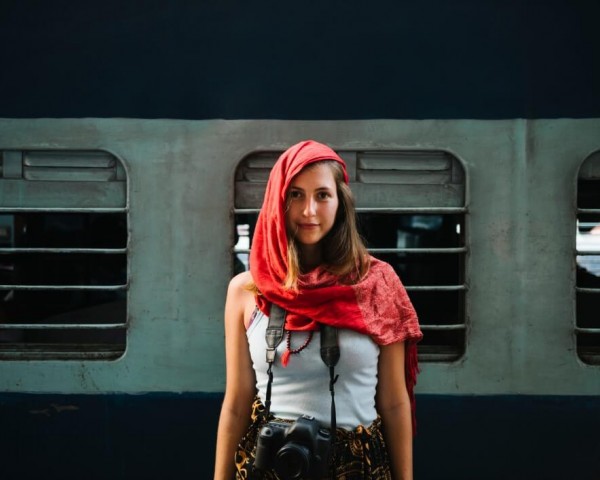People are running to catch the moving train, some holding the sliding door, others already sitting on the platforms. A queue leads to the security gates at the entrance, and it’s crowded. There are people in suits and ties and others in flip-flops, each carrying their lives in a single bag. India’s railway network is the fourth largest globally, spanning 126,000 kilometers of track.
With over 23 million people traveling by train in India daily, it’s a cheap and immersive way to travel, providing the feeling of crossing the country. However, it’s essential to be well-prepared before embarking on your journey.
Two Types of Trains in India
There are two main types of trains in India: Express and Passenger. The Express trains connect the country’s major cities, such as New Delhi’s capital, to other important cities, like Chandigarh in Punjab. Examples of Express trains include the Vande Bharat Express and the Kalka Shatabdi Express. On the other hand, Passenger trains are local and regional, traveling at a slower pace, making more frequent stops, and offering more affordable fares.
Different Classes of Trains in India
This is one of the remarkable peculiarities of Indian railways: there are many different classes! Here are the main ones, ranging from the most popular class to the most comfortable one.
General class (2S): The working class! Here, there are no berths or air conditioning, only passengers squeezed together on wooden benches. It’s the cheapest, most used, and most crowded option, providing an enjoyable local experience for short distances.
Sleeper class (SL): The most common class on trains has six or even eight berths per compartment. It does not have air conditioning and has windows that open in hot weather. Merchants selling tea and cigarettes come and go in the aisles.
Chairs Cars (CC): If you’re not a fan of sleeping berths, some trains offer air-conditioned carriages with seats. The seats are arranged in three rows on one side and two on the other, providing a more comfortable but potentially noisy environment.
Third AC class (3A): The middle range, air conditioning, and closed windows; six berths per compartment; a kind of superior Sleeper class.
Second AC class (2A): To have a semblance of privacy. The berths are only separated from the corridor by curtains, but they are more comfortable: they have air conditioning and two bunk beds instead of three.
AC Executive Class (EC): The Indian business class version features two rows of two seats without berths. The carriages are calm, and some have a screen integrated into the seats (EA).
First class (1A or AC): Blankets, showers, and catering service are available. The cabins have two to four berths and a door that closes from the inside. This class is the most comfortable and, therefore, the most expensive. A seating version is also available (First AC Chair Car).
Buying a Train Ticket in India
In India, you can purchase a train ticket online, at the station, or through an agency. The easiest method is online booking. Note that second-class (2S) tickets do not require a reservation.
To book your ticket online, visit the official website of Indian Railways: IRCTC (irctc.co.in). Click on “Book Ticket” in the “Ask Disha 2.0” window and enter the departure and arrival cities and the date. To complete the reservation, you must register and have an Indian phone number.
There are usually two ticket offices where you can buy your tickets at the station. Follow the line with the most people for second-class tickets without reservation (2S)! The ticket is valid for any train on the line within 3 hours of purchase for a journey of less than 200 kilometers. For tickets with reservation, you have to queue at the “Reservation Center” or the “Foreign Tourist Counter” and then fill out a form where you indicate the destination, time, and class you want.
The Waiting List System
When a train is full, you are on the waiting list and given a WL (Waiting List) ticket. You can only board if a place becomes available. When this happens, your ticket goes to RAC (“Reservation against cancellation”) or is directly confirmed (“Confirmed”). You can check the status on the IRCTC website under “trains” and then “PNR inquiry.”
Book early, at least a week before your trip to avoid waiting lists. It’s best to book even earlier during the summer or festival period. Otherwise, Indian Railways sells last-minute tickets called “Tatkal,” seats for passengers who cannot make a reservation. To benefit from this, visit the IRCTC website 48 hours before departure, select “Ask Disha 2.0,” fill in your route, and then choose “Tatkal.” There are also tickets reserved for foreign tourists.

On Board the Trains
The experience varies greatly depending on the class chosen. Generally, train carriages in India are very noisy, except in first class. Passengers talk loudly, make phone calls without using headphones, and watch videos or movies without consideration for others. However, if you have a reserved ticket, a meal is included. You may choose between a vegetarian or non-vegetarian meal when purchasing your ticket. The meal service starts with a distribution of snacks, followed by the main course, which includes rice, chicken, and sauce for non-vegetarians. For dessert, passengers in the “Chair Cars” class on a New Delhi-Chandigarh route, for example, can choose between yogurt or ice cream. Additionally, trains in India are generally slow, even those labeled Express. They make regular stops and often run behind schedule.












